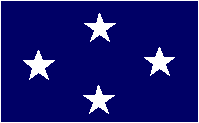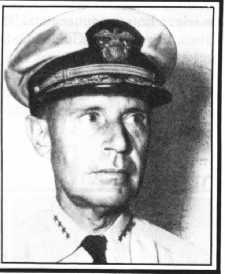

| Admiral
Raymond Ames Spruance
Born: 3 July 1886, Baltimore, Maryland Died: 13 December 1969, Monterey, California Nickname: ? |
 |
Following this battle, Spruance became Chief-of-Staff of the U.S. Pacific Fleet, in which role he had a major part in planning future operations.
In November 1943, he became Commander, 5th Fleet, commanding the Central Pacific Forces, including carriers, battleships and amphibious assets. He once again performed very well, but in the carrier staffs concern arose over the Admiral's battleship conciousness. Leading the Navy across the Pacific via the Marshalls, Spruance got to lead the attack on the Marianas, leading the 5th Fleet into the Battle of the Philippine Sea. There, his air groups decimated the enemy aerial attacks in conjunction with the a new concept for the battleships, in which Spruance would deploy them in the van, shooting down planes even before fighters would attack. Despite not following the beaten Japanese fleet, Spruance's forces sank the medium carrier Hiyo. Spruance has been blamed often for not following the IJN after their retreat. However, this is probably unjust. Spruance's task was to guard the invasion forces and beaches. Besides, if Spruance is to blame, so certainly are the aviation officers responsible for ignoring torpedo-plane training which resulted in only bombs hitting most carriers except Hiyo.
Anyway...after
the Philippine Sea battle, Spruance, for the first time, turned over the
5th Fleet to Admiral Halsey, going back to Pearl Harbor to plan future
landing operations. The invasions of Iwo Jima and Okinawa were partly his
work. He got back to lead the 5th Fleet in battle off those two islands,
still not yet fully clear of his idea of a battleship duel.
Finally returning one last
time to Pearl Harbor, Spruance began planning the operations Olympic, the
invasion of Kyushu, and Coronet, the invasion of Honshu, which he would
have led had the war progressed.
However, with war's end, this was no concern anymore. After the war, Spruance became CinCPAC, for a short term, President of the Naval War College, and U.S. Ambassador to the Philippines.
A quiet,
shy and intelligent officer, Spruance was the ideal man to lead the Navy
in the Central Pacific, despite the problems he sometimes had with naval
aviation. He was always quite interested in the opinions of his staffs,
and would stand to his decisions. Precise and calculating, he was even
better a planner than a combat leader. With due respect to Halsey, it must
be said that of the two, Spruance rated higher for Fleet Admiral promotion,
for he was a better commander, an admirals' admiral, not a sailors' admiral
as Halsey.